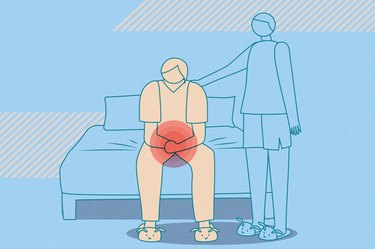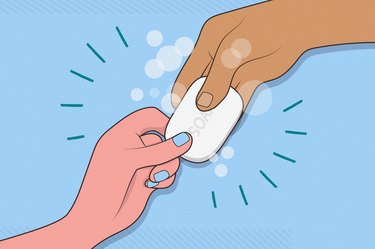
Like the hairstyle on your head, the length you choose to keep your pubic hair is a matter of personal preference. Some like their hair down there long and au naturel while others opt to go totally bare (which, by the way, isn't any more hygienic).
If you do prefer to shave your pubic hair, there are some health risks to consider. Here, Joshua Zeichner, MD, director of cosmetic and clinical research in dermatology at Mount Sinai Hospital in New York City, shares the possible downsides of shaving your pubic hair and how to trim it down safely.
Video of the Day
Video of the Day
First, Why Do We Have Pubic Hair?
While having pubic hair may feel inconvenient at times (think: swimsuit season), your body hair provides a fundamental function.
In general, "body hair serves an evolutionarily purpose," Dr. Zeichner says. For starters, it helps to keep us warm, he says.
"And when it comes to pubic hair, specifically, it is thought to help reduce friction during intercourse and prevent pathogens, like bacteria and viruses, from infecting the genitals," Dr. Zeichner says.
Risks of Shaving Your Pubic Hair
Pubic hair protects your genitals and skin, so naturally, removing it is associated with some risks.
1. You Might Get Razor Burn
Ever get an itchy, tender red rash after shaving your pubic hair?
"Shaving can lead to microscopic cracks or nicks in the outer skin layer, leading to irritation and inflammation that we call razor burn," Dr. Zeichner says. This is a common cause of itchy pubic hair.
While razor burn isn't limited to your bikini zone, the thin skin and complex topography (think: lots of crevices) in your genital region can increase your risk for this type of irritation, he says.
"Because of the sensitivity of your skin and general difficulty in reaching that area, you are more likely to develop grooming-related injuries like cuts on the skin," Dr. Zeichner says.
And with so many nooks and crannies to navigate, it's pretty common to accidentally nick your skin.
In fact, in a survey of 5,674 adults who trim their pubic hair, more than 25 percent reported a grooming-related injury, per a November 2017 study in JAMA Dermatology.
3. You’re More Prone to Ingrown Hairs
Like razor burn, ingrown hairs (i.e., hairs that grow back into the skin) are common when you shave your pubic hair.
"Since hair in the pubic area tends to be coarser and curly, you are more likely to develop an ingrown hair" when you shave, Dr. Zeichner says.
"Plus, if the hair is not smoothly cut with a razor, the edge is more likely to become trapped under the skin," he adds.
Things like using an old or dull razor blade just exacerbate your risk of developing these annoying bumps on your bikini line.
4. You Might Develop Contact Dermatitis
Sometimes certain hair removal products you use to remove pubic hair can be problematic for the delicate skin in that area.
For example, certain ingredients in shaving cream (like fragrances) might result in contact dermatitis — a red, itchy rash often triggered by an allergic reaction to an irritating substance, according to Norton Children's Hospital.
Along with an itchy rash, other signs of contact dermatitis may include the following, per the Mayo Clinic:
- Leathery patches that are darker than usual (hyperpigmented), typically on brown or Black skin
- Dry, cracked and scaly skin, typically on white skin
- Bumps and blisters, sometimes with oozing and crusting
- Swelling, burning or tenderness
While these symptoms are unpleasant, there's good news: Once you identify and stop using the irritating product, the rash typically clears up (in about two to four weeks), according to the Mayo Clinic.
In the meantime, applying a cool, wet cloth can help soothe your skin.
5. You May Develop Folliculitis
"After hair removal, any disruption of the skin barrier (like nicks or cuts) can more easily allow [microbes such as] staph bacteria to penetrate through the follicles," Dr. Zeichner says.
This can lead to pus-filled pimples — also known as folliculitis.
Symptoms of folliculitis include the following, per the Mayo Clinic:
- Clusters of small bumps or pimples around hair follicles
- Pus-filled blisters that break open and crust over
- Itchy, burning skin
- Painful, tender skin
- An inflamed bump
While a mild case of folliculitis will usually resolve on its own, a more serious case might require a trip to the dermatologist who may prescribe an antibiotic or antifungal (depending on the cause of the infection), according to the Mayo Clinic.
6. You Could More Easily Spread or Contract a Sexually Transmitted Infection
As we know, shaving your pubic hair makes you prone to open cuts. That open skin can then leave you vulnerable to infection, because it supplies an easy entryway for pathogens, Dr. Zeichner says.
"This is true of both folliculitis and sexually transmitted diseases that are spread by direct intimate contact," he says.
You don't even need to have sex to increase your odds of a sexually transmitted infection (STI). Simply using a contaminated razor may raise your risk of spreading or contracting an STI, according to Norton Children's Hospital.
How to Safely Shave Your Pubic Hair
Shaving your pubic hair comes with some potential downsides, but proper shaving techniques can help reduce these risks. For a safer shave, follow these instructions by Dr. Zeichner:
1. Trim
If the hair in your pubic area is long, the first step is to use a trimmer to remove excess hair. This will make the shaving process more effective.
Dr. Zeichner recommends the Gillette Intimate Shaving Kit ($80, Gillette), which comes with a trimmer and razor.
"Both were specifically designed to allow for ease of grooming while taking into consideration the needs of both the skin and the hair in this area," he says.
2. Soften the Skin and Hair
The best time to shave is after a shower, when both the hair and the skin are soft and hydrated.
3. Apply a Shave Gel
This protects the skin and allows the razor to smoothly move across the skin.
4. Shave in Single Strokes
Make sure to shave in the direction the hair grows.
5. Clean the Razor Every Two to Three Strokes
Rinsing the razor regularly removes debris between the blades and ensures a smooth shave.
6. Apply a Moisturizing Aftershave
This helps to maintain hydration and skin barrier function. Try a gentle moisturizing cream or lotion that's free from fragrance and other additives. Baby oil and aloe vera gel are also good post-shave options, per Sutter Health.
Other good post-shave moisturizers are Cetaphil Moisturizing Cream ($17.99, Amazon) and Eucerin Advanced Repair Body Cream ($14.53, Amazon).
Alternatives to Shaving Your Pubic Hair
If you prefer your pubic area smooth, shaving isn't your only option. Here, Dr. Zeichner weighs in on other popular hair removal techniques and how they stack up against shaving.
1. Waxing
Many folks favor waxing because the results seem to last longer. Here's why: "When you wax, you are pulling out the hair from the root, so when new hair develops, it is initially thinner," Dr. Zeichner says.
Eventually, though, your hair will re-grow just as thick. "With time, a full, mature hair grows in with the same diameter it was originally," he says. In other words, waxing doesn't have a huge advantage over shaving in this department.
Plus, waxing isn't without its own risks: It can also lead to skin irritation, ingrown hairs or folliculitis, Dr. Zeichner adds, as well as burns and skin damage.
And with this approach, you have to wait until the hair is a certain length before waxing it off, which may be inconvenient.
2. Hair Removal Creams
Depilatory creams like Nair ($16.32, Amazon) — which break down the hair's protein bonds — are safe to use in the genital area, Dr. Zeichner says.
"However, they should not be applied to any open or raw skin or come in contact with any internal parts of the genitals," he adds.
This is because depilatories use chemicals to remove hair and may burn your skin when not applied properly.
Other potential side effects include contact dermatitis, skin darkening from irritation and allergic reactions.
3. Laser Hair Removal
For those looking for a more permanent solution for pubic hair removal, lasers might be your answer.
"Lasers emit a beam of light that specifically targets the pigment in the root of the hair," Dr. Zeichner says.
This light energy damages the hair follicle to keep or delay hair from growing back, per the Mayo Clinic.
But laser hair removal has its drawbacks, too. "Treatments can be uncomfortable, and multiple sessions [which can be costly] are necessary for optimal results," Dr. Zeichner says.
Plus, burns and hypopigmentation (lighter patches of skin, which can be permanent) are possible side effects, especially for people with darker skin.
That's why it's important to go to a board-certified dermatologist or another practitioner who specializes in the use of lasers, to reduce these risks.
So, How Bad Is It Really to Shave Your Pubic Hair?
Turns out, your pubic hair plays an important role in protecting the delicate skin in your genital area. Ultimately, when you shave down there, you may increase your odds of health issues like skin irritation and infections.
Still, if you prefer the shaved look, you can reduce these risks by using proper shaving technique.
Ultimately, the length of your hair anywhere on your body comes down to your personal preference.
- JAMA Dermatology: “Prevalence of Pubic Hair Grooming–Related Injuries and Identification of High-Risk Individuals in the United States”
- Norton Children’s Hospital: “Removing pubic hair can have various health risk”
- Mayo Clinic: “Contact dermatitis”
- Mayo Clinic: “Folliculitis”
- Sutter Health: “Pubic Hair Removal: Shaving”
- Mayo Clinic: "Laser Hair Removal"
Is this an emergency? If you are experiencing serious medical symptoms, please see the National Library of Medicine’s list of signs you need emergency medical attention or call 911.



